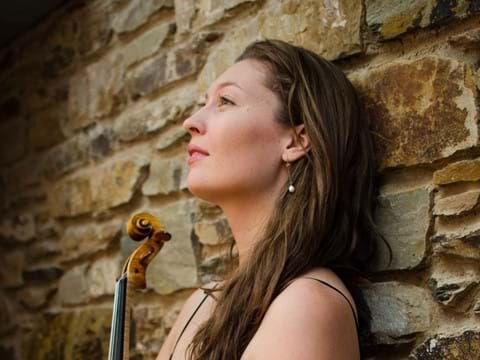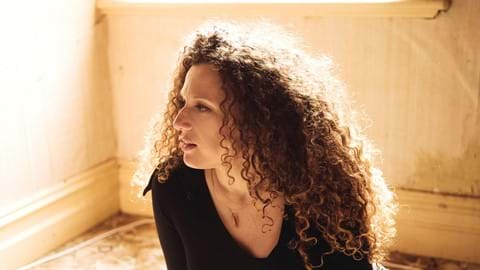The multi-talented violin and recorder player Simone Slattery joins us for a quick chat ahead of her upcoming national tour with baroque ensemble Van Diemen's Band from 26 April to 14 May 2022.
In between rehearsing for this tour and preparing for her Masterclasses in Perth and Melbourne, Simone managed to find some time to talk to us about Van Diemen's Band, borderlands and early music in general.
How would you characterise the early music scene in Australia?
The early music scene in Australia is a diverse, wonderful, and ever-evolving thing! Australian musicians have always travelled, studying and working overseas and returning home at various intervals. This constant ebbing and flowing of performers and pedagogues has shaped the early music scene here significantly, and allowed it to remain fresh and inspired. Van Diemen’s Band is a case in point: an ensemble deeply rooted in baroque performance practice, but willing to push the boundaries of that tradition through innovative programming and collaborations. To me, this characterises the early music scene in Australia more than anything else. After all, here in Australia we are making music that we consider ‘old’ on a continent of much, much older musical traditions, in a place where it is crucial to both honour the past while looking to the future.
What do you find particularly inspiring about the ensemble being based in Tasmania?
Tasmania is an inspiring place in so many ways. The breathtaking beauty of the landscape, and the quality of the art that is produced there really is world-class. I’ve always had the sense that Tasmanian’s support and celebrate their local artists, and I respect that deeply. Van Diemen’s Band are basically early music celebrities on the island!
What is it about early music that interests you?
Early music is full of diversity, there is always something new to discover, whether it’s a new manuscript, or a new treatise describing performances practices from the time. The music itself can range from the outrageously beautiful, to the wild and wonderful, and everything in between, just like life itself!
For an audience that may be new to early music, can you tell us about the differences between the modern and baroque violin and/or the history of the specific instruments you play? (any surprising differences, how it’s played, or anything they should watch out for/take note of when you perform?)
My violin was made in 1726 in Paris by Claude Pierray, and every time I take it out of its case I feel like I’m holding a piece of history in my hands. Along with baroque features such as strings made from sheep and cow gut, audiences may notice the lack of chin and shoulder rests on the violins and viola, and endpin on the cello. Our bows are also very different from modern bows, curved outward in a way that allows us to ‘speak’ the music in a much more rhetorical way. The sound world of a baroque ensemble is very different to that of a symphony orchestra for example, and it can take the ears a while to adjust to the subtler sound palette. Once the ears do adjust however, audiences will discover an incredible depth of sounds that only the gut strings and baroque instruments can produce, full of warmth, earthiness and nuance.
Van Diemen’s Band have released several CD recordings in the last few years. How is the process of preparing for a live performance different to recording a CD? Is there one that you prefer more than the other?
The preparation process is similar, but the act of recording is very different from performing live. There is a magic in live performance that is very difficult to capture in the recording context. And there is the added benefit of having multiple chances to get something right in recording which you don’t have the luxury of in performance!
What is the rehearsal process like for a Van Diemen’s Band concert? Are there any special traditions that you follow when preparing for a performance?
Rehearsals are a wonderful process of discovery. Intonation, articulation, and phrasing are all prominent features of discussion in rehearsal, but perhaps more important are the things that are discovered without the need for discussion, such as the sound of a particular combination of players and the unique energy they create together.
The program explores the historic borderlands of Europe, alongside newer works from Icelandic composer Sigfúsdóttir and the ensemble’s own Donald Nicholson. How do these pieces fit together to tell the stories from the past? (and into the present world events – if you feel comfortable discussing)
One of my favourite things about instrumental music is its capacity to tell a story without words. Music can transport you through time and space. This program explores the historic borderlands of Europe, but audiences can shape their own internal story while listening to the music, whether that reflects on the borders of Europe in baroque times, or the effects of Australia’s recent border closures, or the devastation of current events in Ukraine.
For classical music enthusiasts who aren't as familiar with early music, why would you encourage them to check out a performance?
Good quality music is timeless, so whether a piece was written 1720 or 2020, it will have the power to move the human soul, and goodness knows we all need a bit of soul nourishment these days.
Tickets to the upcoming performance are available here.
Don't miss the opportunity to discover Simone's musical process live when she presents a Masterclass in Perth on 27 April and a Masterclass in Melbourne on 13 May. Tickets are available here.


